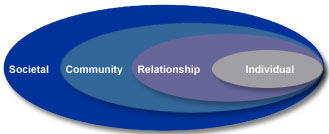Neighborhood characteristics as predictors of Intimate partner violence
 I find the social-ecological model to be a helpful concept in understanding prevention because it highlights the importance of thinking beyond the individual level to create lasting change. However, so much of the research on sexual violence and intimate partner violence focused on the individual.
I find the social-ecological model to be a helpful concept in understanding prevention because it highlights the importance of thinking beyond the individual level to create lasting change. However, so much of the research on sexual violence and intimate partner violence focused on the individual.
I was pleased to see the recently epublished study Neighborhood Characteristics as Predictors of Male to Female and Female to Male Partner Violence. While the study did not find links between intimate partner violence and the neighborhood characteristics examined, the study asks the of type questions that researchers should investigate.
What community based measures do you think might be associated with sexual violence and intimate partner violence?
For the full citation and link to the abstract on the journal’s web site follow the jump.
Neighborhood Characteristics as Predictors of Male to Female and Female to Male Partner Violence.
Caetano R, Ramisetty-Mikler S, Harris TR. Journal of Interpersonal Violence 2009; ePublished December 29, 2009
Click here for the abstract on the journal’s web site.
(Copyright © 2009, Sage Publications)
This article examines the association between neighborhood characteristics at the census tract-level, couples’ perceived neighborhood social cohesion and informal social control, and male-to-female (MFPV) and female-to-male (FMPV) partner violence in the United States. Data come from a second wave of interviews (2000) with a national sample of couples 18 years of age and older who were first interviewed in 1995. The path analysis shows that poverty is associated with perceived social cohesion and perceived social control as hypothesized. However, there is no significant mediation effect for social control or social cohesion on any type of violence. In the path analysis, Black ethnicity is associated with social cohesion, which is associated with MFPV. Intimate partner violence (IPV), as a form of domestic violence, may not be as concentrated in high-poverty neighborhoods as criminal violence. IPV may be more determined by personal and dyadic characteristics than criminal violence.
Note: This study used the revised Conflict Tactics Scale. As I have noted before, many researchers have concerns about this instrument.

Dr. Patricia East has researched neighborhood characteristics in relation to sexual violence experienced by siblings. I’ll send the article when it is published. I too, have seen very little research on this subject.